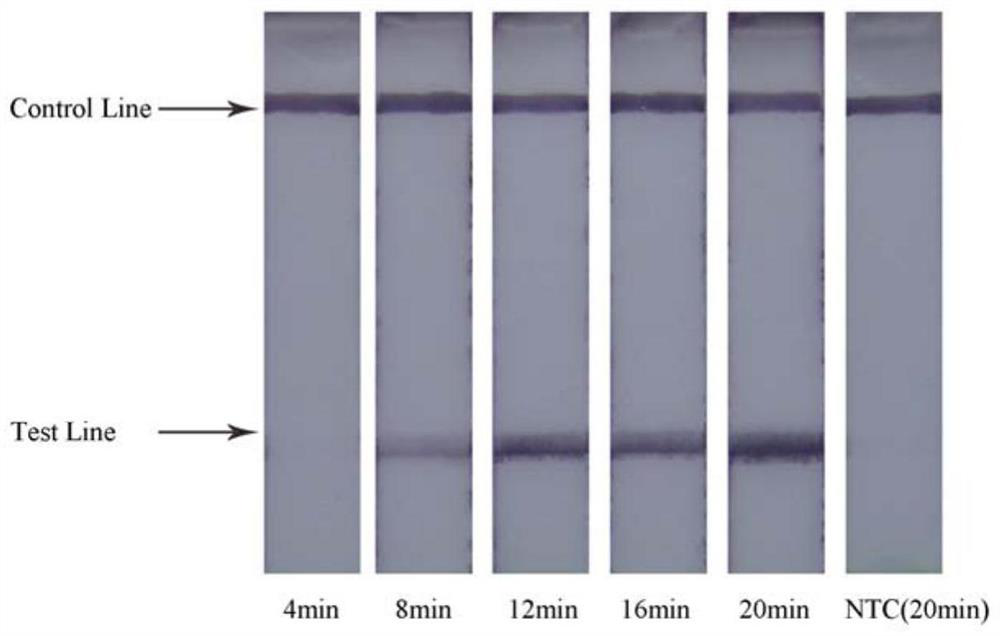A detection method for food-borne pathogen Salmonella
A technology for food-borne pathogenic bacteria and salmonella, which is applied in the field of microbial screening, can solve the problems of easy misjudgment, long detection cycle, and large workload, and achieve simple detection, effective salmonellosis outbreaks, and inhibition of salmonellosis. The effect of the outbreak
- Summary
- Abstract
- Description
- Claims
- Application Information
AI Technical Summary
Problems solved by technology
Method used
Image
Examples
Embodiment 1
[0028] Example 1: Design and screening of primers and probes:
[0029] Primers were designed based on the Salmonella invasion protein (invasion protein A, invA) encoding gene invA gene, and the public invA gene sequence (U43272.1) was found through NCBI. According to the conservative region, after homology analysis, it was located at 101-672 RPA primer design for the target fragment.
[0030] Design 3 sets of primer pairs for optimal primer screening, the primer sets and sequences are as follows:
[0031] Group 1:
[0032] Forward primer F1-RPA: 5′-TTGTTGTCTTCTCTATTGTCACCGTGGTCC-3′ (30bp)
[0033] Reverse primer R1-RPA: 5′-ACTTCATCGCACCGTCAAAGGAACCGTAAA-3′ (30bp)
[0034] Product length: 231bp
[0035] Group 2:
[0036] Forward primer F2-RPA: 5′-TGTCTTCTCTATTGTCACCGTGGTCCAGTT-3′ (30bp)
[0037] Reverse primer R1-RPA: 5′-ACTTCATCGCACCGTCAAAGGAACCGTAAA-3′ (30bp)
[0038] Product length: 227bp
[0039] Group 3:
[0040] Forward primer F3-PRA: 5′-GGCGATAGCCTGGCGGTGGGTTTTGTTGTCTT-3′ (32bp)
[0041]...
Embodiment 2
[0063] Example 2 Detection sensitivity and specificity of primer probes
[0064] Set 5 groups of different concentrations of Salmonella DNA templates (the DNA concentration gradient is 100, 10-1, 10-2, 10-3, 10-4, 0) to perform nucleic acid amplification under the optimal conditions for RPA.
[0065] Refer to the Salmonella DNA extracted from the DNA extraction kit instructions, and the original concentration of the extracted DNA template (511.7ng / μL) was diluted 10-fold to 100ng / μL, 10ng / μL, 1ng / μL, 100pg / μL, 10pg / μL , 1pg / μL, 100fg / μL, 10fg / μL, 1fg / μL, respectively take 1μL as the reaction template. Perform nucleic acid amplification according to the aforementioned sample loading method, and detect the amplified product LFD:
[0066] The results show that the primer and probe combination designed in the present invention can ensure the sensitivity during detection, and the detection sensitivity is 5 fg / μL of final DNA concentration, which is equivalent to 5 CFU / mL. When the templ...
Embodiment 3
[0069] Example 3 Detection and application of actual samples
[0070] 1. Sample purchase:
[0071] Aquatic products come from the aquatic product circulation market, including sea melon seeds (Moerella iridescens), razor clams (Sinonovacula constricta), mussels (Mytilidae), clams (Clam), and blood cockles (Sanguinolaria) (10g net content per serving).
[0072] 2. Sample preparation
[0073] 2.1 Non-frozen samples should be stored in a refrigerator at 7℃~10℃ immediately after collection, and tested as early as possible.
[0074] 2.2 Shellfish take all contents, including shellfish meat and body fluids. For shellfish, first wash the shell in tap water and dry the surface moisture, then open the shell with aseptic operation and take the corresponding part according to the above requirements.
[0075] 2.3 Take a sample of 10g aseptically, add 90mL of Buffered Peptone Water (BPW), homogenize with a rotating blade homogenizer at 8 000r / min for 1 min, or slap with a slap homogenizer for 2 min ...
PUM
 Login to View More
Login to View More Abstract
Description
Claims
Application Information
 Login to View More
Login to View More - R&D
- Intellectual Property
- Life Sciences
- Materials
- Tech Scout
- Unparalleled Data Quality
- Higher Quality Content
- 60% Fewer Hallucinations
Browse by: Latest US Patents, China's latest patents, Technical Efficacy Thesaurus, Application Domain, Technology Topic, Popular Technical Reports.
© 2025 PatSnap. All rights reserved.Legal|Privacy policy|Modern Slavery Act Transparency Statement|Sitemap|About US| Contact US: help@patsnap.com



